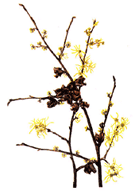
Witch Hazel
Introduction
This fact sheet provides basic information about Witch Hazel. Witch hazel grows as a deciduous bush or small tree, often reaching about 20 feet in height. The plant is found throughout most of North America. Its broad, toothed leaves are ovate, and the golden yellow flowers bloom in the fall. Brown fruit capsules appear after the flowers, then when ripe, eject its two seeds away from the tree. The dried leaves, bark, and twigs are used medicinally.Witch hazel is a widely known plant with a long history of use in the Americas. One source lists more than 30 traditional uses for witch hazel including the treatment of hemorrhoids, burns, cancers, tuberculosis, colds, and fever. Preparations have been used topically for symptomatic treatment of itching and other skin inflammations and in ophthalmic preparations for ocular irritations.
The plant is used in a variety of forms including the crude leaf and bark, fluid extracts, a poultice, and commonly as witch hazel water. The latter, also known as hamamelis water or distilled witch hazel extract, is obtained from the recently cut and partially dormant twigs of the plant. This plant material is soaked in warm water followed by distillation and the addition of alcohol to the distillate. Witch hazel water is the most commonly found commercial preparation, usually kept in most homes as a topical cooling agent or astringent.
Traditionally, witch hazel was known to native North American people as a treatment for tumors and eye inflammations. Its internal use was for hemorrhaging. Eighteenth century European settlers came to value the plant for its astringency, and it is still used today for this and other purposes.
Common Names
Witch Hazel, Hamamelis, Snapping Hazel, Winter Bloom, Spotted Alder, Tobacco Wood, Hamamelis WaterLatin Names
Hamamelis viginianaWhat It Is Used For
- Research reveals no clinical data regarding the use of witch hazel for any condition. Witch hazel is thought to have astringent and hemostatic properties, making it potentially useful as a skin astringent to promote healing in hemorrhoid treatment, diarrhea, dysentery, and colitis, as well as other skin inflammations such as eczema. It also has been used as a gargle to treat mucous membrane inflammations of the mouth, throat, and gums. Witch hazel has been used to treat damaged veins, bruises, and sprains; it is also claimed that it rapidly stops bleeding and that it is useful as an enema for inwardly bleeding piles.
How It Is Used
Tea is a very popular way for administering witch hazel. To create a witch hazel tea, add 2 to 3 grams of witch hazel leave to boiling water for about 15 minutes. Witch hazel tea can be taken two to three times a day. As a tincture, take 2-4 mL three times a day.What the Science Says
- Research reveals no clinical data regarding the use of witch hazel for any condition.
Side Effects and Cautions
- Information regarding safety and efficacy in pregnancy and lactation is lacking.
Sources
- Drugs.Com Web site. Accessed on February 7, 2009.
- From Wikipedia, the free encyclopedia. Accessed on February 7, 2009.






